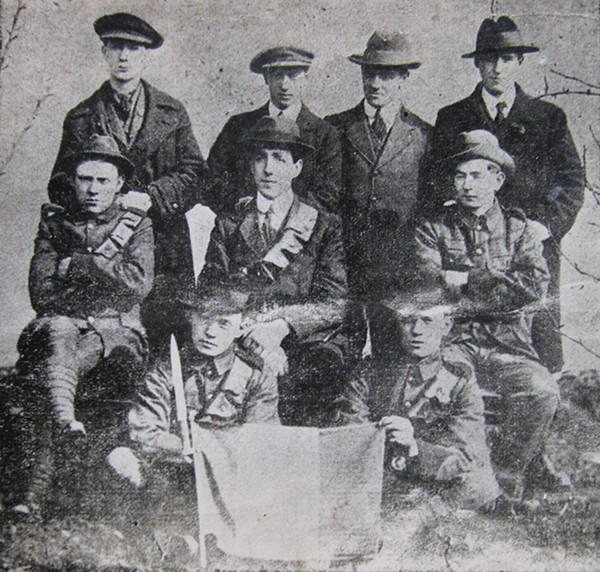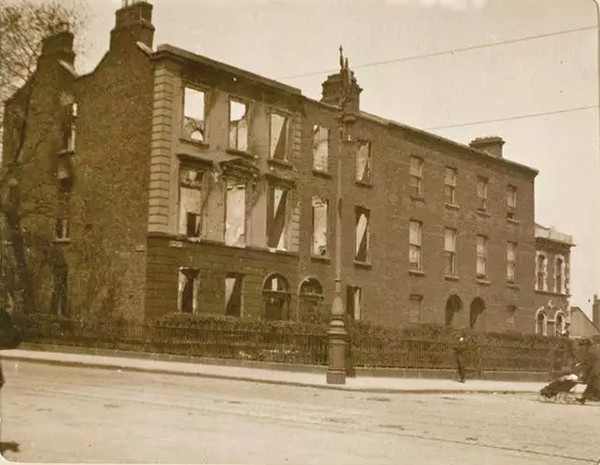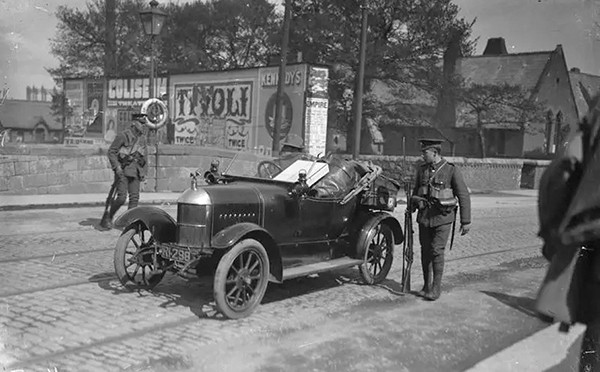
Pictured: The nine survivors of the Mount street battle, Back row: Seamus Grace, Michael Byrne, Joe Clarke, Patrick Roe. Middle row: Willie Ronan, Pat Doyle, James Doyle. Front Row: Jim Walsh, Tom Walsh.
On Easter Monday, April 24th, 1916, as Pádraig Pearse, Commander of the Irish Rebels, prepared to read the Proclamation of the Irish Republic from the steps of the GPO, battalions of Irish Volunteers were occupying strategic positions throughout the city in order to defend the newly-declared Republic.
One of these battalions, under the command of Éamon de Valera, occupied the Boland’s area, including the Mills and the Bakery, close to Mount Street Bridge, a key crossing point between Dublin and Kingstown (Dun Laoghaire).
De Valera and his Second Lieutenant, Michael Malone, had reconnoitred the area sometime earlier to choose outposts for a mission designed to prevent British reinforcements, disembarking at Kingstown, from reaching the City Centre.
The Irish Volunteers C. Company, 3rd Battalion, Dublin Brigade, trained and paraded at Camden Row. Early on Easter Monday morning the Company was mobilised to Earlsford Terrace, where they were issued with Mauser ammunition by Dick Carroll, the Company Quartermaster.
At about 11am the men, under the command of Captain Simon Donnelly, marched to Mount Street Bridge where they met with Lieutenant Michael Malone. He instructed James Grace, Commander of No. 4 Section, to take two young Volunteers Paddy Roe and Michael Byrne to the junction of Haddington Road and Northumberland Road to cover the gates of Beggars Bush Barracks.
Section Commander George Reynolds, Jimmy Doyle, Richard Murphy and Willie Ronan were sent to take over Clanwilliam House. Joe Clarke, Joe Christian and Joseph Doyle were sent to take over the Mission Hall, Northumberland Road, and Section Commander Dinny Donoghue and four or five Volunteers were told to occupy the Schoolhouse opposite the Mission Hall.
When the garrisons of Clanwilliam House, Mission Hall and the Schoolhouse were installed, Malone, Grace, Roe and Byrne took possession of 25 Northumberland Road and prepared the building for a state of siege, erecting barricades from the furniture and ensuring food and water supplies for a couple of days. The Cussens, who owned 25 Northumberland Road, were sympathetic to the cause and had already vacated the house.

Pictured: The shell of Clanwilliam house.
Almost immediately the Volunteers in 25 Northumberland Road were involved in clashes with a Company of GWs (part of a local Home Guard unit) marching towards their garrison at Beggars Bush.
Four of the GWs were killed and more were injured. Unknown to Malone and Grace the GWs were unable to return fire as their rifles were unloaded.
According to Grace’s witness statement, recorded later by the Bureau of Military History (1913-1921), from that point on the Volunteers were subjected to persistent sniping. They gave as good as they got. One sniper in the house opposite 25 Northumberland Road was “particularly troublesome.” Grace attracted fire from him from an upstairs window, losing his cap to a bullet in the process, giving Malone who was a crack shot the opportunity to take him down, which he duly did.
At some point the men occupying the Schoolhouse were instructed to return to the Boland’s area leaving seventeen men to defend the remaining outposts.
Late on Tuesday night, Malone resolved to send Roe and Byrne on “despatch work”. In fact he had decided that they were both too young – he believed that they were sixteen or seventeen, according to Grace’s testimony – to face what was to come, a fight they could not win. The boys were reluctant to go but nevertheless obeyed his command, escaping through a skylight to make their way to Malone’s house in South Circular Road to “await orders.”
Exhausted from lack of sleep and in spite of the overwhelming odds against them, including the failure of expected German aid to arrive and the confusion caused by countermanding orders from GHQ, Malone and Grace were determined to hold their positions.
At about 1pm on Wednesday, April 26th, word came that the English troops had landed at Kingstown and were on their way. Some of the young recruits of the Sherwood Foresters who were advancing towards the city were so inexperienced that many had to be shown on the pier at Kingstown how to fire and reload their weapons.
As they reached the junction of Northumberland Road and Haddington Road, Malone and Grace opened fire, as did the Volunteers based in Clanwilliam House and the Mission Hall. They were supported by sniper fire from Boland’s Bakery and from the nearby railway tracks. Three of the Volunteers positioned at Clanwilliam House lost their lives in the ensuing battle. The surviving four escaped through the rear of the building and evading capture.
The men based at Mission Hall ran out of ammunition and attempted to escape via Percy Lane, at the back of the building, where they were apprehended by British troops.
Lieutenant Malone was shot dead by British soldiers when they stormed 25 Northumberland Road. Grace survived by hiding behind a stove in the basement but he was later captured and sent to prison.
The British troops suffered heavy casualties, in part due to the decision taken by their commander, General Lowe, that Mount Street Bridge had to be taken “at all costs”.
Throughout the day his men, led by officers, charged into the path of the fire, even though there were alternative routes into the city. The resulting carnage saw four British officers dead and 216 other ranks of the Sherwood Foresters killed or badly wounded. Four civilians were also killed in the crossfire.
The brave Volunteers of C. Company, 3rd Battalion, Dublin Brigade, held off the advancing British troops for over nine hours.

Pictured: A British checkpoint at Mount street bridge.
The Battle of Mount Street Bridge has been compared to The Battle of Thermopylae where a group of 300 Spartans battled against an army of over 10,000 Persian invaders and held them at bay until they were betrayed by one of their own. To this day the British army use it as an example of Guerrilla war tactics in officer training courses.
By Jennifer Reddin



